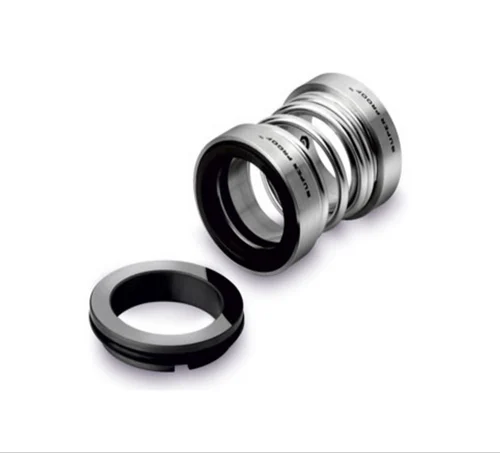
Single-Spring Mechanical Seals: What They Are and How They Work
Single-spring mechanical seals have proven to be of great importance in different industries where there is a requirement to keep various fluids within a system. A single spring mechanism in these seals comes quite handy for those specific operations as these seals are often required to handle harsh environments containing dirty or thick fluids. The information provided in this blog relates to the most important elements of single-spring mechanical seals such as their structure, advantages, kinds, and uses.
What are Single Spring Mechanical Seals?
Single-spring mechanical seals consist of two main parts, an upper housing part and a lower housing part, enclosed over a simple spring placed outside the sealing ring. Multifunctional usage is achieved in many cases due to the presence of only one ‘spring’ thrust. In addition, single spring mechanical seals are very suitable for applications that require non-clogging and self-cleaning. Differences in the structure make troubles in operating inefficient — multi-spring seals can clog.

Key Benefits of Single-Spring Mechanical Seals
- Efficient Handling of Contaminated Liquids: Due to their open-coil spring design, single-spring seals can handle viscous or contaminated liquids more effectively. This feature makes them suitable for applications where non-clogging and self-cleaning operations are essential.
- Long-Term Durability: These seals are known for their resilience against wear and tear, making them a long-lasting solution in industrial environments. Their simple structure contributes to their reliability under tough conditions, including elevated heat and pressure.
- Ease of Assembly and Maintenance: With fewer parts compared to other mechanical seals, single-spring seals are easy to assemble or dismantle. This simplicity not only reduces installation time but also facilitates maintenance, as there is less complexity in reassembling the seal when needed.
- Versatile Designs: Single-spring seals are available in balanced and unbalanced designs, offering flexibility for different applications. The balanced version is suitable for higher-pressure applications, while the unbalanced version can handle moderate pressures.
- Compatibility with Gland Packing Systems: One of the significant advantages of single-spring seals is their compatibility with existing gland packing systems. This design feature allows for a straightforward conversion to a mechanical seal without requiring major modifications.

Types of Single-Spring Mechanical Seals
Single-spring mechanical seals are available in several designs to accommodate various operational needs and fluid types. Some of the commonly used types include:
- Single Spring Balanced Seals: Suitable for applications with higher pressures, balanced seals help distribute pressure across the seal faces, reducing wear and extending the seal’s lifespan.
- Single Spring Unbalanced Seals: Ideal for moderate-pressure applications, unbalanced seals are a cost-effective solution for managing lower-pressure environments without sacrificing performance.
- Single Coil Spring Seals: These seals are compact and efficient, ideal for general-purpose applications that demand a straightforward, non-clogging solution.
- Conical Spring Seals: Often used in smaller equipment, conical spring seals provide effective sealing in compact spaces, where larger seals may not be practical.
- Wave Spring Seals: Designed for applications where axial space is limited, wave spring seals offer a compact yet efficient alternative, particularly useful in confined machinery setups.
Applications of Single-Spring Mechanical Seals
Single-spring seals are highly adaptable and find applications across a range of industries. They are particularly valuable in handling fluids with specific characteristics, such as:
- Viscous Liquids: The single-spring design efficiently handles thick, viscous fluids without clogging, making it ideal for applications in industries like food processing and chemicals.
- Abrasive Liquids: Single-spring seals are durable enough to withstand abrasive particles, making them suitable for environments where fluid may contain solid particles, such as mining and wastewater treatment.
- Crystallizing or Solidifying Liquids: Some fluids tend to crystallize or solidify under certain conditions. Single-spring seals prevent clogging, enabling a smooth operation even in such challenging environments.
- Non-Corrosive Slurries: The robust design of these seals allows them to handle slurry fluids effectively, ensuring leak-free and consistent performance.
- Non-Corrosive Liquids: In industries where the fluid is non-corrosive, single-spring seals offer a simple, cost-effective sealing solution that requires minimal maintenance.
Conclusion
Single-spring mechanical seals provide a highly efficient solution for managing fluids, particularly in challenging environments with viscous, abrasive, or potentially clogging liquids. Their straightforward design, coupled with balanced and unbalanced options, makes them a versatile choice across industries. Whether handling crystallizing fluids or working with non-corrosive slurries, these seals deliver reliable, long-term performance with minimal maintenance.
For industries looking for a durable, easy-to-maintain, and effective sealing solution, single-spring mechanical seals remain a top choice, ensuring fluid handling is efficient, safe, and contamination-free.

1 comment on “Single-Spring Mechanical Seals: What They Are and How They Work”